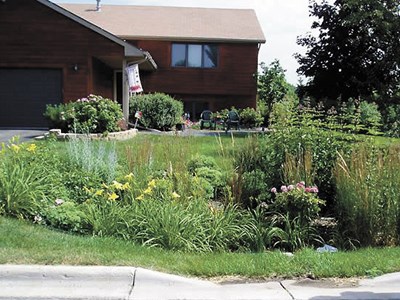My brother asked me how he could give his very wide, very depressed gravel ditch at the front of his country home a more aesthetic appeal. After some thought, it occurred to me that a rain garden might be just the thing.
What’s a rain garden? This type of landscaped perennial bed is intended for the collection of rainwater and snowmelt. A proper rain garden is a shallow depression, set away from the house that helps to recharge the groundwater.
It also prevents toxic pollutants from entering our water systems — fertilizers, animal waste, oil and gas all get washed into the drain if there isn’t a system in place to prevent it. Thus, the rain garden, aptly named, can filter this run-off, slowly percolating it into the ground.
A conventional lawn can’t quite compete with the same quality of filtering as a rain garden. In fact, almost 30 per cent more water will enter the ground through a rain garden.
The soil is of particular importance for a rain garden. If you are creating a depression or are working with an established one, you’ll want to note how the water collects. Is it sandy? Clay-ey? Silty?
The type of soil you have will determine the time of percolation: too slow and you risk rotting the roots of your plants. Too fast and the purpose may be defeated.
The Rutgers College website suggests digging an eight-inch hole and filling it with water to saturate the soil. Once it has drained, refill the hole with water. If it drains within a few hours, the soil is acceptable and you can move forward.
Amending the soil will be your first job, after determining the location. It is suggested that the garden be moved away from the home, yet a well-placed garden, under a sloped roof can also collect run-off.
The topography of your property will help to determine the site. Ideally, you are building this bed on a one to 10 per cent slope and away from any septic systems and underground wires.
You also want to consider full-partial sunlight or shade. If the area receives too much shade, you risk attracting mosquitoes and other pesky insects.
The right amount of light will encourage a variety of plants (the more native the variety, the better) and, thus, beneficial insects. Make sure you mulch and edge to help slow down the water’s flow.
Intercepting runoff is an important role our gardens can play. “Non-point source pollution” is doing damage to our water sources — think blue-green algae blooms that shut down our beaches.
A clean water solution is really a community project, and should start in your own backyard.
Anne Boulton is an avid gardener who lives in Sudbury. Visit her blog at greenboots.ca or contact her at [email protected]
Posted by Vivian Scinto
